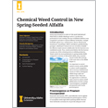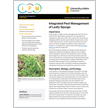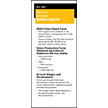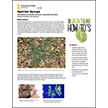Weeds
Black medic ( Medicago lupulina ) is an annual or short-lived perennial from Eurasia. It can be found in lawns, pastures, rights-of-way and other marginal sites. Learn how to manage this...
Broadleaf Plantain (Plantago major L.)
Broadleaf plantain is a hardy perennial weed that thrives in lawns, fields and roadsides and in other areas prone to trampling. Along with a profile description, this Idaho Green Thumb How-To's...
Bull Thistle: Identification and Control
Bull thistle is a biennial, which means it typically takes two growing seasons to complete its life cycle. This video will introduce you to the life cycle of Bull thistle, how to identify it,...
Centrocoris volxemi—A Newly Introduced Idaho Insect
Centrocoris volxemi is an introduced non-native true bug (insects with piercing-sucking mouthparts) that has been expanding its known range in the United States since 2020 and Idaho the year after.
Chemical Weed Control in New Spring-Seeded Alfalfa
Weed management is one of the most important practices in alfalfa production, particularly in new seeding. This bulletin briefly discusses two chemical-based approaches: preemergence or preplant...
Effective Termination of Cover Crops before Planting Cash Crops
Because of legitimate concerns about weed potential, Idaho farmers often hesitate to plant cover crops, even though the practice improves soil health and fertility, among other documented benefits.
Covers the biology, detection and management of this invasive aquatic plant. Includes illustrations and descriptions of similar species and estimated costs for various control options, including...
Flowering Rush is an invasive, aquatic, perennial weed listed as a "noxious" weed by the Idaho State Department of Agriculture (ISDA). This fact sheet provides basic information on identification,...
Integrated Pest Management of Leafy Spurge
Leafy spurge is a highly invasive and aggressive weed that forms dense stands, significantly reducing the carrying capacity of rangelands or pastures by 50% to 75%. Part of an integrated pest...
Iris Yellow Spot Virus: A Threat to Seed- and Bulb-Onion Crops in Idaho
Iris Yellow Spot Virus is a powerful viral pathogen that drastically slows onion growth, leading to major crop loss and higher production costs. It first appeared in Idaho in 1989, but has since...
Italian Ryegrass Management in Inland Pacific Northwest Dryland Cropping Systems
Widespread herbicide resistance in Italian ryegrass makes integrated weed management strategies difficult for this problematic weed. Learn about the multiple control methods and their combination...
Meadow Deathcamas in the Pacific Northwest
Found in all areas of the Pacific Northwest, meadow deathcamas (Toxicoscordion venenosum) is capable of killing livestock whether eaten as forage or in dried hay. Human poisonings have been...
Nightshade: Biology and Control in the Pacific Northwest
Covers nightshade distribution in the Pacific Northwest; identification of hairy, black, cultleaf and bittersweet nightshades; nightshade biology and toxicity; crop damage; and control practices...
Una mala hierba venenosa 'nociva,' la nuez blanca crece rápidamente y puede sofocar y matar a los árboles pequeños y arbustos. Aprenda sus características y cómo identificarla y controlarla en este...
This two-page fact sheet for use in the field offers recommendations for growing onions in Idaho, with pointers or information on growth stages and development, planting, fertilization, irrigation,...
Pacific Poison-oak and Western Poison-ivy: Identification and Management
Pacific poison-oak and western poison-ivy are both native to the Pacific Northwest. All parts of these plants contain urushiol, an oily toxin that can cause an allergic reaction of contact...
Pigweeds: Current and Emerging Weed Threats in the Pacific Northwest
Pigweed is an invasive plant pest usually found in disturbed areas, like farmland and along roadsides and fencelines. Because their aggressiveness can reduce crop yields, this PNW discusses how to...
With a spiny fruit capable of injuring hooves, feet and vehicle tires, growers from across the spectrum can learn to effectively manage this weed. Authors: Dale K. Whaley, Robert Parker, Rick...
Rush skeletonweed is an exotic herbaceous biennial or creeping perennial plant that aggressively infests rangeland, cropland and disturbed areas. Along with explanations of management strategies,...
Russian Olive Trees: Control and Management in the Pacific Northwest
Russian olive trees are fast-growing plants that since the 1950s have become invasive throughout many areas of the Inland Pacific Northwest, particularly in riparian ecosystems. They form...
Spotted Spurge (Chamaesyce maculata; Synonym: Euphorbia maculata)
Spotted spurge is a summer weed that grows close to the ground in sidewalk cracks, roadsides, gardens or drought-stressed lawns. Its presence can be helpful, because it often indicates an...
Western Waterhemlock in the Pacific Northwest
Western waterhemlock ( xCicuta douglasii ) is the most poisonous plant in North America — a piece of root no larger than a walnut can kill a mature cow. Every part of the plant is toxic. To help...
An abundant seed producer, wild carrot grows in meadows, pastures, along roadsides and in non-crop areas. A Class B noxious weed in Washington, the pest ruins cultivated carrot seed and possibly is...





























